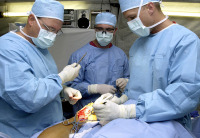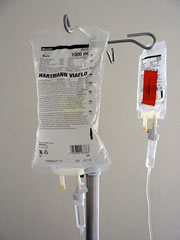Treatment
Breast cancers involve a variety of different cell types and, as a result, no two diagnoses are the same. The treatments available depend primarily on the type and stage of the cancer.
Surgery
Surgery is usually the first treatment considered by doctors when faced with a patient with breast cancer. Different types of surgery can be carried out depending in the nature of the cancer.
A Lumpectomy is where surgeons excise the cancerous lump from the breast.
A Mastectomy is where the whole amount of breast tissue is removed.
The lymph nodes under the arm (axillary lymph nodes) may be removed if tests show metastasis to these regions.
In high risk cases of breast cancer, but where the cancer has not yet developed, a prophylactic mastectomy may be considered. This is a mastectomy performed in order to prevent the future development of breast cancer.
Image courtesy of https://commons.wikimedia.org/wiki/File:Surgeons_at_Work.jpg The image is in the public domain and thus free of any copyright restrictions.
Radiation Therapy
In order to reduce the risk of the cancer returning after surgery, radiation therapy is often undertaken. During radiation therapy the cancer cells are subjected to levels of radiation that should prevent them from growing and spreading further. Normal cells are also affected by the radiation, but not as severely as the cancer cells.
Studies have shown a 70% non-recurrence rate in women who had radiotherapy in conjunction with a lumpectomy.
Radiation is offered to patients with all stages of breast cancer-it is especially useful after a lumpectomy as it can kill any leftover cancer cells.
Two types of radiation therapy are used, either external (where a machine delivers a beam of radiation) or internal (where “seeds” which give off radiation are deposited around the site of the cancer) - internal radiation is much less commonly used.
The level of radiation required is dependent upon such things as the size of the breast cancer, whether the cancer was metastatic and the level of lymph node involvement.
Chemotherapy

Chemotherapy can be used as an adjunct to lumpectomy to treat early stage breast cancer-here the hope is that the chemotherapy (which uses drugs to weaken and destroy the cancer cells) will remove any cancerous cells left behind.
Chemotherapy can also be used in advanced stage cancers in an attempt to remove or weaken the cancer cells.
Chemotherapy is useful because it can attack rapidly-dividing cancer cells both at the original site of the cancer and throughout the body, where the cancer may have spread.
Chemotherapy can be used before or after surgery. If it is given before surgery, it is known as “nonadjuvant” chemotherapy- the aim is to shrink the cancer cells. “Adjuvant” chemotherapy is given after surgery, as soon as recovery begins.
Chemotherapy targets cells which grow and divide very rapidly- typical characteristics of cancer cells. However, chemotherapy can affect other cells in the body, which is why it causes side effects ranging from fatigue and nausea to hair loss and weight problems.
Image courtesy of https://commons.wikimedia.org/wiki/File:Infuuszakjes.jpg Public Domain image
Hormonal Therapy
The majority of breast cancers are what is known as hormone receptor positive. The cancer may have receptors for either oestrogen or progesterone. If a cancer is oestrogen receptor positive, for example, then oestrogen can signal to the cells to grow and divide.
The aim of hormonal therapy in this case is to lower the levels of oestrogen in the body, or to act as receptor antagonists, so that the cancer will shrink or be prevented from recurring after surgery.
